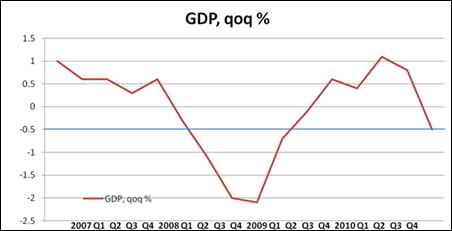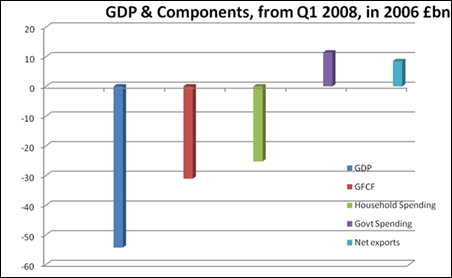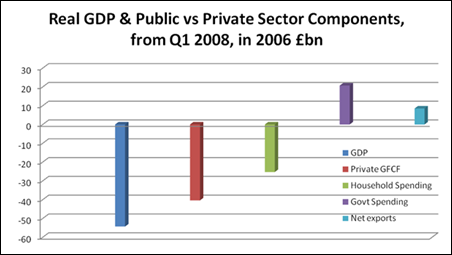.814ZLong-term and short-term cyclical prospects for US growth
By John Ross
Gavyn Davies, chair of Fulcrum Asset Management and former head of global economics at Goldman Sachs, launched a discussion on his Financial Times blog on prospects for US economic growth. This, among other issues, refers to material which has appeared here.
This discussion, as both Gavyn Davies and the present author note, highlights the need for clarity in distinguishing between short-term cyclical and longer term trends in US growth and problems in perspective that arise if the two are conflated.
The aim of the present article is therefore to provide some precise numbers which clarify these points. This also gives parameters by which to judge US short (and long) term growth performance as economic data is released – the US will publish new GDP data, for the 4th quarter of 2010, on 28 January.
Assumptions on US economic growth
Gavyn Davies referred to an article which appeared here entitled “The long term slowing of the US economy”. This noted the progressive long term deceleration of the US economy.
If a 20 year moving annual average of US GDP growth is compared at 10 yearly intervals, then 20 year annual average growth to the 3rd quarter of 1970 was 3.8%, to the 3rd quarter of 1980 3.6%, to the 3rd quarter of 1990 3.2%, to the third quarter of 2000 3.2%, and to the 3rd quarter of 2010 2.5%. For further details readers are referred to the article.
Gavyn Davies confirmed the article’s overall trend conclusion on the long term deceleration of US growth and provided further information on US GDP per capita GDP, which had not been dealt with in the article. He commented: “The rate of [US] growth has clearly slowed down in recent decades. I do not think this trend has been arrested or reversed, but there could still be scope for several years of cyclical recovery.”
I strongly agree with emphasising this distinction and it therefore further clarifies the discussion if definite numbers are plugged in.
Gavyn Davies, and Jim O’Neill chairman of Goldman Sachs Asset Management, both suggest as parameters of strong US growth performance in the coming period figures in the region of an annualised 3-4%.
Gavyn Davis noted positively: “according to the ISM business surveys and much other data published lately, the growth rate of [US] GDP may have risen to around a 3.5 to 4 per cent rate.” Jim O’Neill wrote: “A number of quarters of 3-4% or more real GDP growth are likely in the next couple of years.”
Certainly, compared to recent US growth performance, an annualised 3-4% would be high – the current US 5 year average annual growth is 0.9% and current 3 year growth is zero.
However, it should be noted that such stronger cyclical growth would still be insufficient to halt the long term slowing of the US economy. To show this Figure 1 shows the 20 year moving average for US GDP growth with two projections for the next two years 2011 and 2012 – that US growth is 3% or 4% in the nine successive quarters from the latest available data (the 3rd quarter of 2010) to the end of 2012. Figure 2 shows the same projections using a 10 year moving average.
It may be seen from Figures 1 and 2 that neither a 3% or a 4% growth rate sustained over the next two years would be sufficient to reverse the long term deceleration of the US economy.
Figure 1

Figure 2

Results of projections
Taking first a 20 year moving average, if a 3% US growth rate were maintained to the end of 2012 the 20 year US annualised growth rate would advance from 2.5% to 2.7%. If 4% growth were maintained for two years then the US 20 year moving growth average would be 2.8%.
However in the 4th quarter of 2007, that is the quarter before the start of the current US recession, the 20 year moving average growth rate was 3.0% – and as can be seen from Figure 1 this was a decline from the US rate of growth in previous decades. Therefore neither 3% nor 4% growth for the next two years would be sufficient to reverse the long term decline in the US growth rate.
Turning to a 10 year average, 3% growth over the next two years would take the 10 year US growth rate to 2.0% and 4% growth would take it to 2.3%. However the US 10 year moving average growth in the 4th quarter of 2007 was a significantly higher 2.9%.
Therefore annual average US GDP growth over years of 3-4%, as may be seen from Figures 1 and 2, would be insufficient to halt the declining trend of US 10 year GDP growth.
Longer term projections
It is indeed striking that even if 3-4% annual growth were continued for over four years, until the 4th quarter of 2014, this would still not be enough to reverse the slowing long term trend of US growth. A 4% US growth rate sustained until the end of 2014, for 17 successive quarters, would take the 20 year annual average of US growth to 2.8% and the 10 year average to 2.4%. A 3% US growth rate sustained until the end of 2014 would take the 10 year annual average growth rate to 2.0% and the 20 year annual average to 2.6%.
In neither case would this be sufficient to take the long term US growth rate back to pre-recession levels.
Recovery in business cycles
This above data illustrates, of course, that trends and cycles are not separate. Closer examination indicates that the long term slowing of the US economy is due not simply to deeper recessions, most notably the present one, but to slower growth during expansions. Long term deceleration of the US economy is a result both of the depth of recessions and of the relative slowing of recoveries.
To illustrate this the fundamental data regarding successive US business cycles is illustrated in Figure 3. This shows economic growth in each US cycle since 1973. The lines show the development from the peak of the preceding cycle, through the cyclical recession, to the final quarter of growth before the next recession – the year indicated for each line is the starting year of the cycle. For comparison a 2.5% annual growth trend line and a 1.7% annual growth trend line are shown – these being respectively average 20 year and 10 year US annual growth to the latest available data.
Figure 3

The fundamental trends shown by Figure 3 are clear. The current business cycle naturally saw the deepest fall of US GDP in any post-World War II recession. The 1973, 1980 and 1990s cycles culminated in annual average growth over the cycle above the 2.5% trend, while the 2000 and 2007 cycles showed growth below it – which simply illustrates in detail the long term slowing of the US economy.
The 2007 recession shows a trend which is so far significantly below both the 2.5% 20 year annual average and the 1.7% 10 year US average. Failure of US growth to eventually finish above these figures over the cycle would confirm a further slowing of the US economy.
Comparisons of US growth
Such trend rates of US growth in previous cycles give an appropriate benchmark for considering US economic recovery. Evidently, if a comparison is made to extreme scenarios then US performance might appear strong.
Jim O’Neill, for example, makes a comparison to Japan’s two decade long stagnation after 1990: “My hunch for the surprise of 2011 is that the US will positively shake people up… I believed that in spite of the considerable challenges for the consumer, the US economy would not fall into a Japan-style abyss of a lost decade or two. The evidence that the US will not go down this route will, I suspect, be this year’s surprise.”
By comparison to Japan’s post-1990 performance US performance of course would appear robust. But only if it were held that there was a major chance the US could enter a Japanese 1990s style stagnation would the fact that it did not do so constitute a surprise. An exaggerated standard of comparison has the inevitable effect of making US economic performance appear “strong”.
When making a more sober and quantitative standard of comparison, however, Jim O’Neill’s data is not precise and therefore obscures an appropriate comparison – precisely the slowing trend of US long term growth. He writes: “underlying productivity performance, together with its relatively more favourable demographic dynamics, suggested to me that the US might at some stage shift back into a growth trend of close to 3%… the behaviour of both the Federal Reserve and post midterm election Congress has probably allowed the momentum to take the US back into its growth trend…. A number of quarters of 3-4% or more real GDP growth are likely in the next couple of years.”
But, as the data given above shows, 3 per cent has not been US trend growth for more than 20 years – as noted 20 year US trend growth is 2.5% and 10 year trend growth is 1.7%. Nor, as illustrated above, would 3-4% GDP growth over the next couple of years reverse the long term slowdown of the US economy.
Speed of growth in previous US expansions
Indeed figures of 3-4% growth during recovery would be significantly below those experienced in US business cycles. For example, US GDP in the third quarter of 2010, the latest available data, was 0.6% below its peak in the 4th quarter of 2007 – i.e. after 11 quarters. By chance 11 quarters after the start of the US double dip recession of 1980 (in 4th quarter 1982), the previous most serious US post-World War II recession, US GDP was also 0.6% below its peak. The annualised growth in the succeeding quarters was then 5.0%, 9.0%, 7.9% and 8.3% – i.e. of a totally higher order of magnitude than the 3-4% recovery rates currently being projected in this US business cycle.
Even if the post-1980 cycle is discounted as being particularly strong, the post-1990 cycle saw three quarters with more than 6% annualised US GDP growth and six quarters additional quarters with more than 5% annualised growth – i.e. nine quarter of above 5% annualised growth. So “a number of quarters of 3-4% or more real GDP growth are likely in the next couple of years” would not represent a strong performance.
It is true that the post-2000 cycle only saw two quarters with more than 5% annualised growth but this precisely reflected the slowing of the US economy to the 2.5% 20 year average and 1.7% 10 year moving average. The projections made by Jim O’Neill would, therefore, not constitute strong US economic growth in historically comparative terms and would be insufficient to reverse the long term slowdown of the US economy. This is a more appropriate scale of comparison.
Glass half-full and glass half-empty
Finally, to summarise the importance of the necessary distinction between short term cyclical and longer term trends, the old analogy of a glass half-full or a glass half-empty might be used.
Taking first the “glass half-full”, the above data shows there is considerable potential for a near term US cyclical upturn even within the framework of a long term slowing of the US economy. If the reasonable assumption is made that the long term deceleration of US growth is determined by structural factors, and long term acceleration cannot occur without a change in these structural factors, then it is nevertheless clear from the above data that even without any structural changes US growth could average 3-4% over the next two years – i.e. such a growth rate would not require overturning the structural elements creating long term US slowing. This is simply because 3-4% growth over the next two years would actually be consistent with the pattern of long term slowing of the US economy, and would be weaker than in previous cyclical recoveries.
This, of course, is not a prediction that US growth over the next two years will average 3-4% – this depends on more short term factors. It is merely a statement that there would appear to be no element in the data on long term trends in US growth that would prevent an acceleration of growth to 3-4% over the next two year period. This might well have favourable consequences for US equity and other markets – that is, the short term cyclical pattern might be considered a “glass half-full”.
But the “glass half-empty” is that even growth rates of the 3-4% type projected over the next two years, or even for a four year period, would be insufficient to reverse the long term deceleration of the US economy. Only a US recovery at growth rates substantially above those currently projected, and/or sustained for significantly long periods, would reverse the trend of the long term slowing of the US economy.
Conclusions
What conclusions derive from the above? Two self-evidently “spectacular” perspectives for the US economy, either a 1929 style depression or a post-1990 Japanese style stagnation, are not supported by the data. However a more “mundane” but significant one is. The US economy has been decelerating for several decades. None of the rates of growth presently projected for cyclical US recovery are sufficient to reverse this gradual but long term slowing of the US economy.
This result may appear more prosaic than some other scenarios, but given the central role played by the US in the world economy its results are likely to to be profound.
Gavyn Davies’ initiating of a thorough, and clarificatory, discussion on prospects for US growth is therefore very welcome.
* * *
This article originally appeared on the blog Key Trends in Globalisation.John Rosshttps://www.blogger.com/profile/08908982031768337864noreply@blogger.com0








Recent Comments